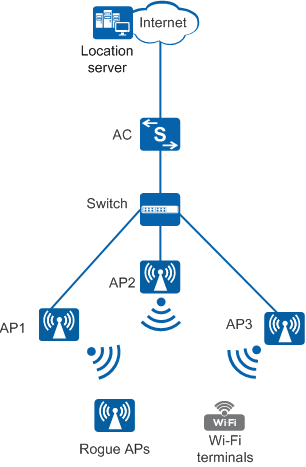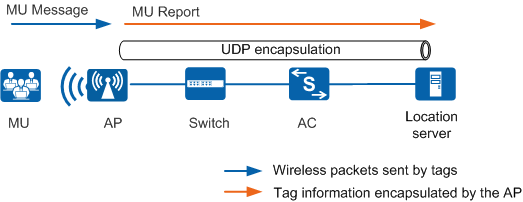AeroScout MU Location
Concepts
As shown in Figure 1, the AeroScout mobile unit (MU) location system includes at least three APs, one or more ACs, and an AeroScout location server. Functions of each component are as follows:
- AP: The APs collect wireless signals. The APs periodically switch channels to collect strength information about signals of MUs in the surrounding environment on each channel and report the collected information to the AC or location server.
- AC: The AC forwards the configuration instruction from the location server to APs. It can also forward location information received from an AP to the location server.
- Location server: The location server computes the MU location using a location algorithm (for example, three-point location) after receiving the location information and provides the computed data to user systems, including the system management software and image software.
Implementation
The protocol process of the AeroScout MU location system is similar to that of the AeroScout tag location system. However, the two systems locate different devices. The AeroScout MU location system locates mobile terminals while the AeroScout tag location system locates tags.
Figure 2 shows the AeroScout MU location principle, which is similar to terminal location.
After the AeroScout MU location function is enabled, APs receive MU messages and forward them to the location server.
- After receiving an MU Message frame, an AP records location information contained in the frame such as the received signal strength indicator (RSSI), time stamp, rate, and channel. The RSSI is the most important information because the location server uses it to determine the distance between an MU and an AP.
The AP encapsulates all location information obtained from MU Message frames into a UDP packet (MU Report) and sends the packet to the location server directly or through the AC.
The destination IP address and port number of an MU Report packet are configured on the AC.- If the destination address is set to the IP address of the location server, the MU Report packet is directly sent to the location server.
- If the destination address is set to the AC's IP address, the MU Report packet is sent to the AC and forwarded by the AC to the location server. This configuration is used when the AP cannot be directly connected to the location server.
The location server computes the location information.
To accurately determine the MU location, the location server must receive location information about an MU from at least three APs. After receiving the location information, the location server computes the MU location according to information including the RSSI, SNR, radio mode, the imported map, and AP locations. Then, the location server sends the location information to the graphical interface of the third-party device for presentation.

